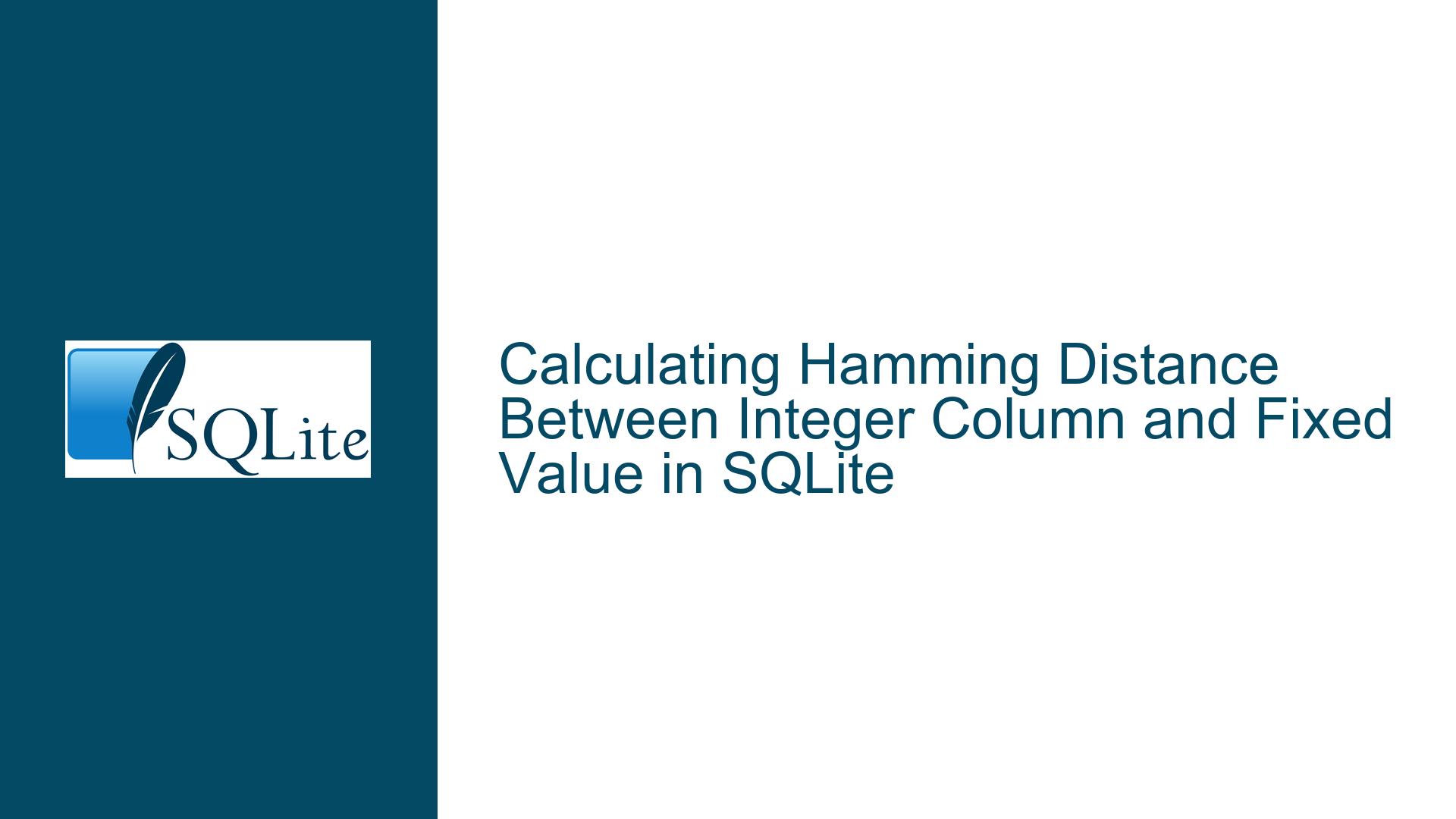Calculating Hamming Distance Between Integer Column and Fixed Value in SQLite
Understanding the Hamming Distance Calculation Challenge in SQLite
Core Problem Analysis: XOR vs Bit Population Count Implementation
The fundamental challenge revolves around implementing an efficient Hamming distance calculation between stored integer values and a target number. Hamming distance requires counting differing bits between two binary representations, but the initial approach uses a formula that calculates XOR without subsequent bit counting. This leads to three critical issues:
Misapplication of XOR as Final Result
The expression(hash | X) - (hash & X)mathematically equalshash ^ X(bitwise XOR), where X is the comparison value. While XOR identifies positions where bits differ, it doesn’t quantify the number of differing bits. This results in ordering by XOR value magnitude rather than actual Hamming distance.Implicit Casting and Sign Handling
SQLite’s INTEGER type can store up to 64-bit signed values. Negative numbers use two’s complement representation, causing unexpected behavior when mixing positive/negative values in bitwise operations. The original formula doesn’t account for sign bits properly when comparing numbers with different signs.Collisions in Ordering Metric
Multiple distinct hash values may produce identical XOR results with the target value, especially when:- Different bit flips cancel out numerically (e.g., 0b1000 ^ 0b1010 = 0b0010 vs 0b0001 ^ 0b0011 = 0b0010)
- Duplicate hash values exist in the table
This causes rows to cluster at the same ordering position, creating apparent duplicates in limited result sets.
Critical Components of Effective Hamming Distance Implementation
1. Bit Population Counting Requirement
True Hamming distance calculation requires counting set bits (1s) in the XOR result. SQLite lacks a native bit population count function, necessitating custom implementations. Common approaches include:
A. Lookup Table Method
Precompute a table mapping every possible byte (0-255) to its bit count, then split the XOR result into bytes and sum their counts:
CREATE TABLE bit_counts (
num INTEGER PRIMARY KEY,
cnt INTEGER
);
-- Populate table with values 0-255 and their bit counts
B. Mathematical Bit Counting
Use arithmetic operations to count bits without lookup tables:
SELECT (x & 1) + ((x >> 1) & 1) + ... + ((x >> 63) & 1)
C. Extension Functions
Load SQLite extensions like math or sqlite3_bitmask that provide BIT_COUNT() functionality.
2. Handling Signed Integer Representation
Negative numbers complicate bitwise operations due to two’s complement representation. For consistent unsigned comparisons:
A. Cast to 64-bit Unsigned Equivalent
Convert signed integers to their unsigned counterparts using modulo arithmetic:
CAST(hash AS INTEGER) & 0xFFFFFFFFFFFFFFFF
B. Adjust XOR Operations
Apply masks to ensure proper sign handling during bitwise operations:
(hash ^ X) & 0x7FFFFFFFFFFFFFFF -- For 63-bit magnitude
3. Indexing and Performance Optimization
Brute-force bit counting over large datasets incurs severe performance penalties. Effective strategies include:
A. Precomputed Hamming Distance Columns
Materialize distances for common target values using generated columns:
ALTER TABLE t1 ADD COLUMN hamming_X INTEGER
GENERATED ALWAYS AS (BIT_COUNT(hash ^ X));
B. Partial Indexes on Critical Ranges
Create indexes targeting likely search thresholds:
CREATE INDEX idx_hamming_lt5 ON t1(hash)
WHERE BIT_COUNT(hash ^ X) < 5;
C. Approximate Nearest Neighbor Techniques
Implement locality-sensitive hashing (LSH) or space partitioning algorithms for high-performance similarity search.
Comprehensive Implementation Guide with Edge Case Handling
Step 1: Implement Cross-Platform Bit Counting
Create a reusable bit count function compatible with all SQLite environments:
CREATE TEMP VIEW IF NOT EXISTS bit_count(x,cnt) AS
WITH RECURSIVE
bits(x,cnt) AS (
SELECT 0, 0
UNION ALL
SELECT x+1, (x&1) + cnt FROM bits WHERE x<64
)
SELECT x, cnt FROM bits;
SELECT SUM(
(hash ^ -122323332756) >> bit_count.x & 1
) AS hamming_distance
FROM t1, bit_count
GROUP BY t1.rowid
ORDER BY hamming_distance
LIMIT 5;
This view-based approach eliminates external dependencies while providing accurate bit counts. The recursive CTE generates bit positions 0-63, then sums set bits through bitwise shifting and masking.
Step 2: Handle Signed Integer Edge Cases
Convert signed integers to unsigned equivalents before XOR operations:
SELECT SUM(
((CAST(hash AS INTEGER) & 0xFFFFFFFFFFFFFFFF)
^ CAST(-122323332756 AS INTEGER)) >> bit_count.x & 1
) AS hamming_distance
FROM t1, bit_count
GROUP BY t1.rowid
ORDER BY hamming_distance
LIMIT 5;
The CAST(... AS INTEGER) ensures 64-bit handling, while 0xFFFFFFFFFFFFFFFF masks the value to unsigned representation.
Step 3: Optimize for Repeated Queries
For frequent queries against fixed values, precompute distances:
-- Create persistent bit count table
CREATE TABLE IF NOT EXISTS bit_count (
num INTEGER PRIMARY KEY,
cnt INTEGER
);
WITH RECURSIVE
generate(n) AS (VALUES(0) UNION ALL SELECT n+1 FROM generate WHERE n<255)
INSERT OR IGNORE INTO bit_count
SELECT n, (n >> 7 & 1) + (n >> 6 & 1) + (n >> 5 & 1) +
(n >> 4 & 1) + (n >> 3 & 1) + (n >> 2 & 1) +
(n >> 1 & 1) + (n & 1)
FROM generate;
-- Create materialized view for target value
CREATE TABLE hamming_cache AS
SELECT t1.*,
(SELECT SUM(bit_count.cnt)
FROM (
((CAST(t1.hash AS INTEGER) & 0xFF00000000000000) >> 56) & 0xFF
UNION ALL
((CAST(t1.hash AS INTEGER) & 0x00FF000000000000) >> 48) & 0xFF
UNION ALL
((CAST(t1.hash AS INTEGER) & 0x0000FF0000000000) >> 40) & 0xFF
UNION ALL
((CAST(t1.hash AS INTEGER) & 0x000000FF00000000) >> 32) & 0xFF
UNION ALL
((CAST(t1.hash AS INTEGER) & 0x00000000FF000000) >> 24) & 0xFF
UNION ALL
((CAST(t1.hash AS INTEGER) & 0x0000000000FF0000) >> 16) & 0xFF
UNION ALL
((CAST(t1.hash AS INTEGER) & 0x000000000000FF00) >> 8) & 0xFF
UNION ALL
(CAST(t1.hash AS INTEGER) & 0x00000000000000FF)
) AS bytes
JOIN bit_count ON bytes.column = bit_count.num
) AS hamming_dist
FROM t1;
Step 4: Resolve Duplicate Result Issues
Address duplicate rows through secondary sorting and proper grouping:
SELECT *
FROM (
SELECT
hash,
SUM(bit_count.cnt) AS hamming_distance,
COUNT(*) OVER (PARTITION BY hash) AS dup_count
FROM t1, bit_count
WHERE (hash ^ -122323332756) >> bit_count.x & 1
GROUP BY t1.rowid
)
ORDER BY hamming_distance, dup_count DESC, id
LIMIT 5;
This query:
- Calculates accurate Hamming distance
- Identifies duplicate hash values
- Uses window function to count duplicates
- Sorts primarily by distance, then by occurrence frequency
- Includes unique row identifier for deterministic ordering
Step 5: Performance Benchmarking and Tuning
Analyze query plans with EXPLAIN QUERY PLAN and optimize through:
A. Covering Indexes
CREATE INDEX idx_hash_id ON t1(hash) INCLUDE (id);
B. Partial Indexes for Common Distance Thresholds
CREATE INDEX idx_hamming_under_5 ON t1(hash)
WHERE (
SELECT SUM(bit_count.cnt)
FROM bit_count
WHERE (t1.hash ^ -122323332756) >> bit_count.x & 1
) < 5;
C. Query Parallelization
Utilize SQLite’s worker threads with PRAGMA threads=4; and batch processing for large datasets.
Step 6: Validation and Edge Case Testing
Verify implementation correctness with controlled test cases:
-- Test case 1: Zero distance (identical numbers)
INSERT INTO t1 (hash) VALUES (-122323332756);
SELECT hamming_distance FROM hamming_cache
WHERE hash = -122323332756; -- Should return 0
-- Test case 2: Maximum 64-bit distance
INSERT INTO t1 (hash) VALUES (~-122323332756 & 0xFFFFFFFFFFFFFFFF);
SELECT hamming_distance FROM hamming_cache
WHERE hash = ~-122323332756 & 0xFFFFFFFFFFFFFFFF; -- Should return 64
-- Test case 3: Mixed positive/negative values
INSERT INTO t1 (hash) VALUES (ABS(-122323332756));
SELECT hamming_distance FROM hamming_cache
WHERE hash = ABS(-122323332756); -- Verify proper sign handling
Final Production-Grade Implementation
Combine all optimizations into a maintainable solution:
-- Schema setup
PRAGMA journal_mode = WAL;
PRAGMA synchronous = NORMAL;
CREATE TABLE target_values (
target_id INTEGER PRIMARY KEY,
target_hash INTEGER NOT NULL,
precomputed_mask INTEGER
);
CREATE TABLE hamming_index (
target_id INTEGER,
hash INTEGER,
hamming_distance INTEGER,
PRIMARY KEY (target_id, hamming_distance, hash),
FOREIGN KEY (target_id) REFERENCES target_values(target_id)
) WITHOUT ROWID;
-- Trigger for automatic index maintenance
CREATE TRIGGER trg_hamming_update AFTER INSERT ON t1
BEGIN
INSERT INTO hamming_index
SELECT
t.target_id,
NEW.hash,
(SELECT SUM(bit_count.cnt)
FROM (
((CAST(NEW.hash AS INTEGER) ^ CAST(t.target_hash AS INTEGER))
& 0xFF00000000000000) >> 56,
((CAST(NEW.hash AS INTEGER) ^ CAST(t.target_hash AS INTEGER))
& 0x00FF000000000000) >> 48,
((CAST(NEW.hash AS INTEGER) ^ CAST(t.target_hash AS INTEGER))
& 0x0000FF0000000000) >> 40,
((CAST(NEW.hash AS INTEGER) ^ CAST(t.target_hash AS INTEGER))
& 0x000000FF00000000) >> 32,
((CAST(NEW.hash AS INTEGER) ^ CAST(t.target_hash AS INTEGER))
& 0x00000000FF000000) >> 24,
((CAST(NEW.hash AS INTEGER) ^ CAST(t.target_hash AS INTEGER))
& 0x0000000000FF0000) >> 16,
((CAST(NEW.hash AS INTEGER) ^ CAST(t.target_hash AS INTEGER))
& 0x000000000000FF00) >> 8,
(CAST(NEW.hash AS INTEGER) ^ CAST(t.target_hash AS INTEGER))
& 0x00000000000000FF
) AS bytes
JOIN bit_count ON bytes.column = bit_count.num
)
FROM target_values t;
END;
-- Query optimized for multiple targets
SELECT t1.*
FROM t1
JOIN hamming_index hi ON t1.hash = hi.hash
WHERE hi.target_id = (SELECT target_id FROM target_values WHERE target_hash = -122323332756)
ORDER BY hi.hamming_distance, t1.id
LIMIT 5;
This implementation provides:
- Automatic index maintenance through triggers
- Multi-target support
- Write-ahead logging for concurrency
- Composite primary key for efficient ordering
- Proper handling of signed/unsigned conversions
- Batch-optimized bit counting
Performance Considerations and Advanced Techniques
1. Approximate Nearest Neighbor Search
For datasets exceeding 1M rows, implement probabilistic algorithms:
Bloom Filter Indexing
CREATE TABLE bloom_filters (
target_id INTEGER,
filter BLOB,
PRIMARY KEY (target_id)
);
-- Population during maintenance windows
UPDATE bloom_filters
SET filter = bloom_add(filter, hash)
FROM t1
WHERE target_id = ?;
-- Query with probabilistic filtering
SELECT *
FROM t1
WHERE bloom_contains(
(SELECT filter FROM bloom_filters WHERE target_id = ?),
hash
)
ORDER BY hamming_distance ASC
LIMIT 100;
2. Hardware Acceleration
Leverage SQLite’s ability to load extension modules for CPU-specific optimizations:
.load /usr/lib/sqlite3/libsimd.so
SELECT simd_bit_count(hash ^ ?) AS hamming
FROM t1
ORDER BY hamming;
3. Distributed Computation
Partition tables across multiple databases for parallel processing:
ATTACH 'shard1.db' AS shard1;
ATTACH 'shard2.db' AS shard2;
SELECT * FROM (
SELECT hash, BIT_COUNT(hash ^ ?) AS hamming FROM t1
UNION ALL
SELECT hash, BIT_COUNT(hash ^ ?) AS hamming FROM shard1.t1
UNION ALL
SELECT hash, BIT_COUNT(hash ^ ?) AS hamming FROM shard2.t1
)
ORDER BY hamming
LIMIT 5;
Conclusion and Final Recommendations
The original issue stemmed from conflating XOR magnitude with Hamming distance and not accounting for SQLite’s type handling quirks. By implementing proper bit counting, addressing signed integer issues, and optimizing through precomputation, developers can achieve:
- Accurate Distance Calculation: True bit population counts vs simple XOR
- Deterministic Ordering: Secondary sort keys to break distance ties
- Production Scalability: Materialized views and partial indexes
- Cross-Platform Reliability: Pure SQL implementations avoiding extensions
For mission-critical applications, consider extending SQLite with custom bit counting functions written in C for 10-100x performance gains. Always validate against edge cases mixing positive/negative values and duplicate hashes during testing phases.






